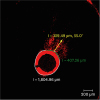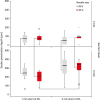1. Haapasalo M, Endal U, Zandi H, Coil JM. Eradication of endodontic infection by instrumentation and irrigation solutions. Endod Topics. 2005; 10:77–102.

2. Gulabivala K, Patel B, Evans G, Ng YL. Effects of mechanical and chemical procedures on root canal surfaces. Endod Topics. 2005; 10:103–122.

3. Zehnder M. Root canal irrigants. J Endod. 2006; 32:389–398.

4. Paqué F, Balmer M, Attin T, Peters OA. Preparation of oval-shaped root canals in mandibular molars using nickel-titanium rotary instruments: a micro-computed tomography study. J Endod. 2010; 36:703–707.

5. Paqué F, Zehnder M, De-Deus G. Microtomography-based comparison of reciprocating single-file F2 ProTaper technique versus rotary full sequence. J Endod. 2011; 37:1394–1397.

6. Abou-Rass M, Piccinino MV. The effectiveness of four clinical irrigation methods on the removal of root canal debris. Oral Surg Oral Med Oral Pathol. 1982; 54:323–328.

7. Carrigan PJ, Morse DR, Furst ML, Sinai IH. A scanning electron microscopic evaluation of human dentinal tubules according to age and location. J Endod. 1984; 10:359–363.

8. Gu Y, Perinpanayagam H, Kum DJ, Yoo YJ, Jeong JS, Lim SM, Chang SW, Baek SH, Zhu Q, Kum KY. Effect of different agitation techniques on the penetration of irrigant and sealer into dentinal tubules. Photomed Laser Surg. 2017; 35:71–77.

9. Ørstavik D. Endodontic filling materials. Endod Topics. 2014; 31:53–67.

10. Mamootil K, Messer HH. Penetration of dentinal tubules by endodontic sealer cements in extracted teeth and
in vivo
. Int Endod J. 2007; 40:873–881.

11. Sadr S, Golmoradizadeh A, Raoof M, Tabanfar MJ. Microleakage of single-cone gutta-percha obturation technique in combination with different types of sealers. Iran Endod J. 2015; 10:199–203.
12. Bolles JA, He J, Svoboda KK, Schneiderman E, Glickman GN. Comparison of Vibringe, EndoActivator, and needle irrigation on sealer penetration in extracted human teeth. J Endod. 2013; 39:708–711.

13. Kara Tuncer A, Unal B. Comparison of sealer penetration using the EndoVac irrigation system and conventional needle root canal irrigation. J Endod. 2014; 40:613–617.

14. Generali L, Cavani F, Serena V, Pettenati C, Righi E, Bertoldi C. Effect of different irrigation systems on sealer penetration into dentinal tubules. J Endod. 2017; 43:652–656.

15. Peters OA. Current challenges and concepts in the preparation of root canal systems: a review. J Endod. 2004; 30:559–567.

16. Dutner J, Mines P, Anderson A. Irrigation trends among American Association of Endodontists members: a web-based survey. J Endod. 2012; 38:37–40.

17. Chow TW. Mechanical effectiveness of root canal irrigation. J Endod. 1983; 9:475–479.

18. Usman N, Baumgartner JC, Marshall JG. Influence of instrument size on root canal debridement. J Endod. 2004; 30:110–112.

19. Falk KW, Sedgley CM. The influence of preparation size on the mechanical efficacy of root canal irrigation
in vitro
. J Endod. 2005; 31:742–745.

20. Sedgley CM, Nagel AC, Hall D, Applegate B. Influence of irrigant needle depth in removing bioluminescent bacteria inoculated into instrumented root canals using real-time imaging
in vitro
. Int Endod J. 2005; 38:97–104.

21. Khademi A, Yazdizadeh M, Feizianfard M. Determination of the minimum instrumentation size for penetration of irrigants to the apical third of root canal systems. J Endod. 2006; 32:417–420.

22. van der Sluis LW, Gambarini G, Wu MK, Wesselink PR. The influence of volume, type of irrigant and flushing method on removing artificially placed dentine debris from the apical root canal during passive ultrasonic irrigation. Int Endod J. 2006; 39:472–476.

23. Perez R, Neves AA, Belladonna FG, Silva EJ, Souza EM, Fidel S, Versiani MA, Lima I, Carvalho C, De-Deus G. Impact of needle insertion depth on the removal of hard-tissue debris. Int Endod J. 2017; 50:560–568.

24. Boutsioukis C, Lambrianidis T, Kastrinakis E. Irrigant flow within a prepared root canal using various flow rates: a computational fluid dynamics study. Int Endod J. 2009; 42:144–155.

25. Munoz HR, Camacho-Cuadra K.
In vivo efficacy of three different endodontic irrigation systems for irrigant delivery to working length of mesial canals of mandibular molars. J Endod. 2012; 38:445–448.

26. Aksel H, Askerbeyli S, Canbazoglu C, Serper A. Effect of needle insertion depth and apical diameter on irrigant extrusion in simulated immature permanent teeth. Braz Oral Res. 2014; 28:1–6.

27. Boutsioukis C, Lambrianidis T, Verhaagen B, Versluis M, Kastrinakis E, Wesselink PR, van der Sluis LW. The effect of needle-insertion depth on the irrigant flow in the root canal: evaluation using an unsteady computational fluid dynamics model. J Endod. 2010; 36:1664–1668.

28. Malentacca A, Uccioli U, Zangari D, Lajolo C, Fabiani C. Efficacy and safety of various active irrigation devices when used with either positive or negative pressure: an
in vitro study. J Endod. 2012; 38:1622–1626.

29. Psimma Z, Boutsioukis C, Kastrinakis E, Vasiliadis L. Effect of needle insertion depth and root canal curvature on irrigant extrusion
ex vivo. J Endod. 2013; 39:521–524.

30. Myers GL, Montgomery S. A comparison of weights of debris extruded apically by conventional filing and Canal Master techniques. J Endod. 1991; 17:275–279.

31. Boutsioukis C, Gogos C, Verhaagen B, Versluis M, Kastrinakis E, Van der Sluis LW. The effect of root canal taper on the irrigant flow: evaluation using an unsteady Computational Fluid Dynamics model. Int Endod J. 2010; 43:909–916.

32. Silva PB, Krolow AM, Pilownic KJ, Casarin RP, Lima RK, Leonardo RT, Pappen FG. Apical extrusion of debris and irrigants using different irrigation needles. Braz Dent J. 2016; 27:192–195.

33. Tanalp J, Güngör T. Apical extrusion of debris: a literature review of an inherent occurrence during root canal treatment. Int Endod J. 2014; 47:211–221.

34. Farook SA, Shah V, Lenouvel D, Sheikh O, Sadiq Z, Cascarini L, Webb R. Guidelines for management of sodium hypochlorite extrusion injuries. Br Dent J. 2014; 217:679–684.

35. Boutsioukis C, Psimma Z, van der Sluis LW. Factors affecting irrigant extrusion during root canal irrigation: a systematic review. Int Endod J. 2013; 46:599–618.

36. Mandorah A. Effect of irrigation needle depth in smear layer removal: scanning electron microscope study. Saudi Endod J. 2013; 3:114–119.

37. Tay FR, Gu LS, Schoeffel GJ, Wimmer C, Susin L, Zhang K, Arun SN, Kim J, Looney SW, Pashley DH. Effect of vapor lock on root canal debridement by using a side-vented needle for positive-pressure irrigant delivery. J Endod. 2010; 36:745–750.










 PDF
PDF Citation
Citation Print
Print




 XML Download
XML Download